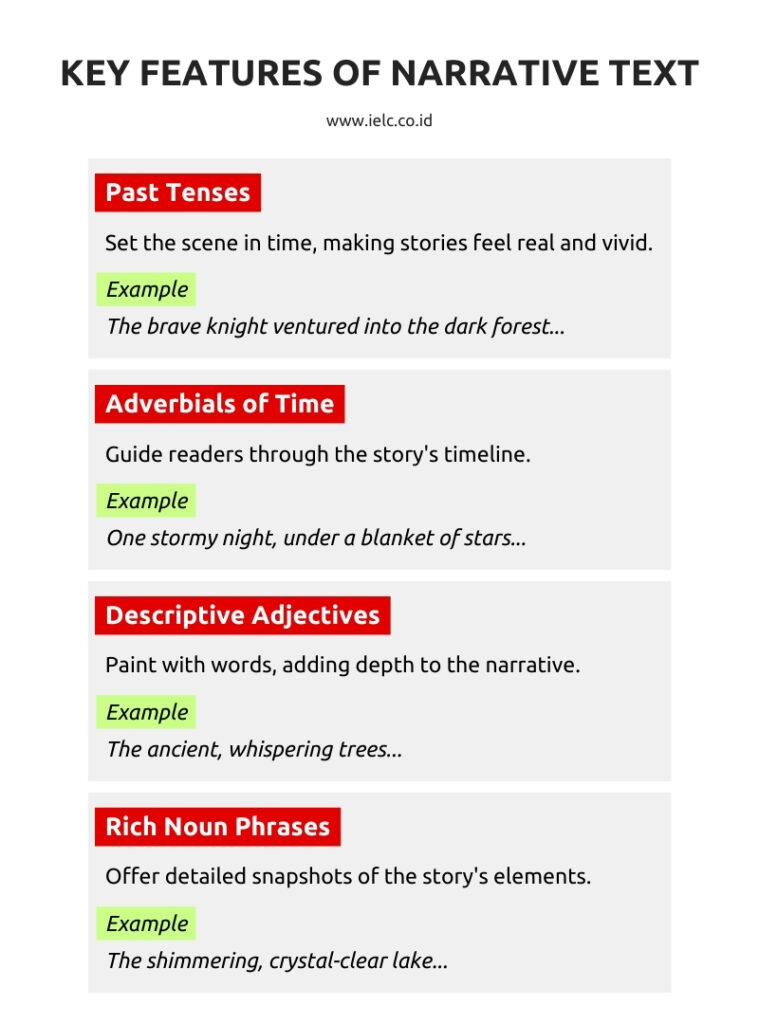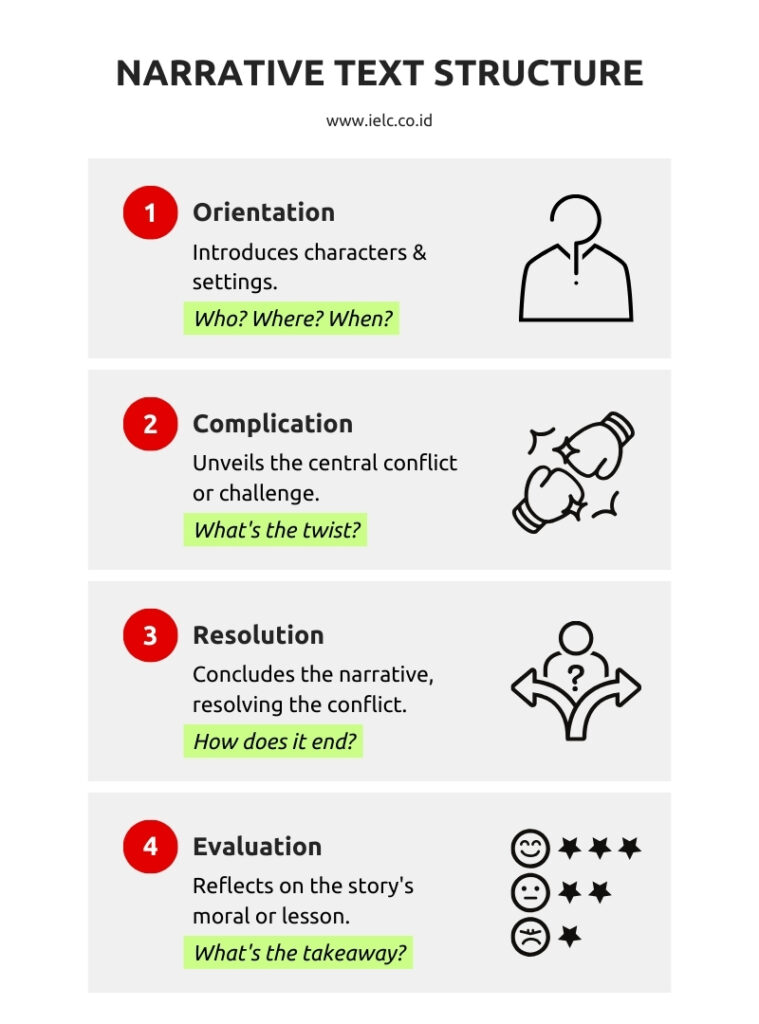
Narrative text – definition, characteristics, functions, types, and example
Hey Learners!
In today’s article, we will learn about narrative texts.
Most of you are probably already familiar with or have at least heard of the term “narrative text,” especially if you enjoy reading fiction.
However, let’s revisit our understanding of narrative text, shall we?
What exactly is a narrative text?
Simply put, a narrative text is a type of text that tells a story or describes a sequence of events. The purpose of a narrative text is to entertain or inform the reader by presenting a series of events in a coherent and engaging way.
What are the characteristics of narrative text?

1. Using past tenses
Narrative texts often contain past tense because they typically recount events or stories that have already occurred.
Using the past tense helps to create a sense of time and sequence, which enables the reader to follow the plot and understand the progression of events.
Also, writing in the past tense gives context and shows a clear link between actions and their results, which helps the reader get into the story and understand what the characters are going through.
Here’s an example:
“Once upon a time, in a small village, there lived a kind, generous old man. One day, as he was walking through the forest, he stumbled upon a giant squash. Amazed, he inched closer.”
In this example, the use of past tenses such as “lived”, “was walking”, “stumbled”, “amazed” and “inched” is used to describe past events.
2. Using adverbial of time
Narrative texts often use adverbials of time to provide a clear structure and sense of progression to the story.
These time expressions help the reader understand when events are happening, how they are related to one another, and the overall flow of the narrative.
By providing a context for the sequence of events, adverbials of time create a more vivid and engaging reading experience.
They enable the reader to follow the plot more easily and immerse themselves in the story, as they can visualize the events unfolding within a specific timeframe.
Here’s an example:
“Early one morning, Sarah decided to go for a jog in the park. As she jogged, the sun began to rise, casting a golden glow over the trees. Later that day, she met her friends for lunch and shared her morning adventure with them.”
In this example, adverbials of time such as “early one morning,” “as she jogged,” and “later that day” are used to provide context and indicate the sequence of events, helping the reader understand when each action took place.
3. Using adjectives
Adjectives are words that describe or modify nouns, or, put it simply, adjectives are words that give more information about a noun such as its color, shape, size, characteristics, etc.
In narrative text, adjectives help create a more detailed and vivid story.
Example: “The brave knight entered the dark, mysterious forest, ready to face any challenges that lay ahead.”
In this example, the adjectives “brave,” “dark,” and “mysterious” add depth to the description, giving the reader a clearer sense of the knight’s personality and the atmosphere of the forest.
4. Using noun phrases
A noun phrase is a group of words that contains a noun along with any accompanying modifiers, such as adjectives, adverbs, or other nouns that provide more information about the main noun. Noun phrases help create detailed and vivid descriptions in stories.
In narrative texts, noun phrases can be used to give more detailed descriptions, highlight certain parts of a character or setting, or explain complicated ideas concisely.
Example: “The bright morning sun cast a golden glow on the calm waters of the lake, creating a breathtaking view.”
In this example, the noun phrases are “the bright morning sun” and “the calm waters of the lake.” These phrases provide more detailed descriptions, with “the bright morning sun” referring to the sun and “the calm waters of the lake” highlighting the lake’s peaceful appearance.
What is the purpose and social function of a narrative text?
The purpose of a narrative text is to tell a story or recount a series of events in an engaging and entertaining way for the reader.
Some narrative texts may also have didactic or instructive purposes, such as teaching moral lessons or sharing information about historical events or specific cultural traditions.
And yes, narrative texts also have social functions, which include entertaining, providing information, and of course, educating the readers.
So, what does the structure of a narrative text look like?

1. Orientation
Orientation sets the stage for the story.
Ideally, the orientation should answer the questions “who,” “where, and “when.”
So, when reading the orientation part, we should be able to identify the character and setting (both time and place) of the story.
2. Complication
This section contains the problems that occur within a story. It is divided into three parts, namely:
- Rising action: Problems begin to emerge
- Climax: Peak of the problem
- Falling action: The tension of the problem begins to decrease, and the solution starts to emerge
3. Resolution
The resolution is the part of the narrative where the conflict or problem introduced earlier in the story is resolved or addressed.
This may involve characters finding a solution to their issues, overcoming obstacles, or experiencing personal growth.
The resolution helps tie up loose ends, providing closure for the reader and allowing them to see how the events of the story have impacted the characters.
4. Re-orientation / Evaluation
Re-orientation, also known as evaluation, is an optional component of a narrative text that serves to reflect on the story and its events, reinforcing the moral lesson or theme.
This section typically appears at the end of the story, providing a summary or commentary on the characters’ experiences and the consequences of their actions.
It helps the reader understand the significance of the story and encourages them to consider the message or lesson the author intended to convey.
The points mentioned above are the basic components of a narrative text structure, but it is important to note that not all narrative texts follow this exact structure.
Some narratives may include additional elements, such as flashbacks, multiple perspectives, or non-linear timelines. Nevertheless, the basic structure described above provides a useful framework for understanding and analyzing narrative texts.
Types of narrative texts:
There are lots of different kinds of narrative texts, such as:
- Fictional narrative
A fictional narrative is a story that is not based on real events or real people. It can be a novel, short story, fable, or fairy tale.
- Autobiography
An autobiography is a narrative text that tells the life story of the author, written from a first-person perspective.
- Biography
A biography is a narrative text that tells the life story of someone other than the author, written from a third-person perspective.
- Memoir
A memoir is a narrative text that focuses on a particular period or event in the author’s life, often written from a first-person perspective.
- Legend
A legend is kind of a folklore. It’s a traditional story that has been passed on for generations – it often explains the origins of a particular culture or society.
Example of a narrative text
In a dense forest filled with vibrant, mystical creatures, there lived a gentle deer named Luna. Her silver coat shimmered in the moonlight, and her sparkling blue eyes held the wisdom of the ages. Luna was beloved by all, as she had the unique ability to heal the wounds and ailments of others.
One day, a fearsome beast invaded the forest, causing chaos and despair among its inhabitants. The once harmonious realm was now filled with fear and anguish, as the beast’s rampage left destruction in its wake. The forest dwellers turned to Luna, seeking her guidance and help to face this grave threat.
Luna, understanding the magnitude of the situation, embarked on a journey to confront the beast. Along the way, she encountered various challenges and tests of courage, each one strengthening her resolve and preparing her for the upcoming confrontation. She also gained valuable allies, as the creatures of the forest united to stand by her side.
Finally, Luna and her companions reached the beast’s lair. As they approached, they discovered that the creature’s ferocious demeanor masked a deep pain – a thorn embedded in its paw. Luna, moved by compassion, used her healing touch to remove the thorn and soothe the beast’s pain.
With the thorn gone, the beast’s anger subsided, revealing a gentle giant grateful for Luna’s kindness. The forest dwellers and the beast formed an alliance, promising to protect and care for one another.
As peace returned to the forest, Luna’s wisdom and compassion became the guiding light for generations to come. Through her actions, she taught her fellow creatures the importance of understanding and empathy, even in the face of fear and uncertainty.
The moral of the story is empathy and understanding can transform conflict into friendship, and true strength lies in the ability to see beyond our fears to find common ground.
Anyway, can you spot the characteristics of a narrative text that we discussed earlier? Can you identify the structure?
Next steps
Do you want to speak English with confidence?
Most people lack confidence when they speak English. They are afraid to make mistakes and are embarrassed to speak in front of others.
This is because they have been taught English the wrong way!
Most English courses waste your time and money on useless exercises that don’t bring results. Even worse, they teach you bad habits that are very difficult to unlearn.
As a result, you become confused and lack confidence. This is wrong!
At IELC, we teach English the right way
Our goal is to get you speaking in English with fluency and confidence as fast as possible. We want to give you the skills you need to fulfill your potential!
Our experienced teachers will guide you along every step of the learning process to ensure that you are not wasting your time, money, and energy on useless language exercises & wrong methods.
Our courses
With our modern campus and technology, we are equipped to provide the best possible courses for children, teens, and adults, including:
Online and on campus IELTS courses
Online and on campus TOEFL PBT courses
Online and on campus TOEFL iBT courses
We offer our classes in group classes or private classes.
No matter what your goals are, our team will help you achieve these goals by providing you with Indonesia’s best English courses!
Talk to our team today to get your FREE consultation and take your first step towards success.
Sincerely,
Anthony McCormick,
IELC Managing Director
